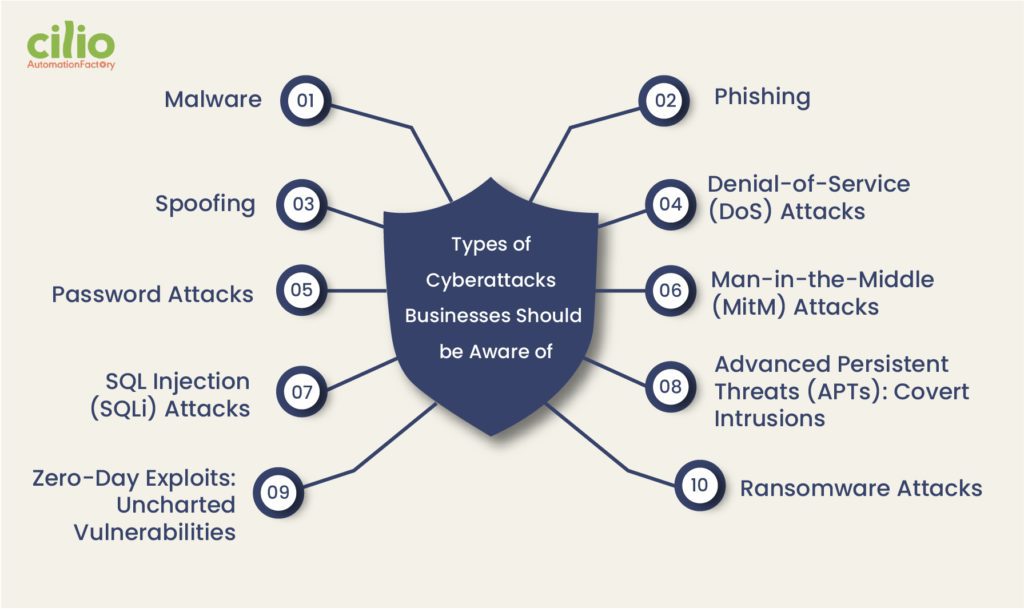Is your data safe? What if anyone is spying on your data and targeting it to steal or misuse it? Clearly, this is the most dangerous position & this phenomenon is known as cyber security threats.
In today’s digital age, where everything from our personal photos to sensitive business documents resides online, safeguarding our data is paramount. Cyberattacks lurk in the shadows of the internet, waiting to strike at vulnerabilities in our systems. These attacks come in various forms as in different types of cyberattacks, each with the potential to wreak havoc on our lives and livelihoods.
let’s see what stats say about Cyberattacks…
- According to threat intelligence, Check Point Research, there was a weekly average of 1,158 attacks per organization worldwide in 2023. Consulting services and software provider IT Governance reported that 8.2 billion records were breached in publicly disclosed attacks during the year.
- A prediction from research & publishing firm Cybersecurity Ventures says that the global cost of cybercrime would hit $8 trillion in 2023 and increase to $9.5 trillion in 2024.
- According to IBM annual report publish, the average cost of data breach at 553 organizations worldwide in the 12 months ending in March 2023 was a record high of $4.45 million.
Cyberattacks can hurt in different ways. They can directly make you lose things like money and work time. But they can also damage your reputation, which can make customers and business partners do not trust you anymore.
But fear not, for there are ways to defend against these digital marauders. By understanding the types of cyberattacks and implementing effective prevention measures, we can fortify our defenses and keep our data safe from harm.
So, let’s delve into the world of cyber warfare and discover how we can protect ourselves against these unseen cyber security threats.
Types of Cyber Attacks You Should Be Aware of

Before delving down to know more about the different types of Cyberattacks, let’s figure out what Cyberattack is and what do cyber attackers target?
In simple words- Cyberattack is a common computer security threat. A cyberattack is when hackers try to mess with computers or the internet. They target all sorts of people and companies, trying to steal money or information, or just cause trouble.
And Cyber attackers don’t pick favorites. They go after anyone with something they want, whether it’s a big company with lots of revenue or a regular person with personal information. They’re like sneaky thieves, trying to break into digital doors to get what they’re after.
Let’s uncover different types of cyberattacks and ways to keep your data safe from such threats:
1) Malware
Malware is like a digital bug that sneaks into your computer or phone. It can make your device act strangely or slow it down a lot. Sometimes, malware can even steal your personal information, like passwords or credit card numbers. It’s important to have good antivirus software to protect against malware. Be careful what you download and click on, so you don’t accidentally let malware in.
2) Phishing
Phishing is a sneaky trick where hackers try to fool you into giving them your private info. They might send fake emails that look real, asking for your password or bank details. Sometimes, they pretend to be from a company you trust, like your bank or a popular website. Always double-check the sender’s email address and be cautious about clicking on links in emails.
3) Spoofing
Spoofing is like someone wearing a disguise online. Attackers can pretend to be someone else by faking their email or phone number. They might pretend to be your friend or a company you trust. Be cautious if someone asks for sensitive info or money online, especially if you weren’t expecting it.
4) Denial-of-Service (DoS) Attacks
DoS attacks are like a digital traffic jam that crashes a website or service. Attackers flood a website with so much traffic that it can’t handle it, making it unavailable to real users. This can be frustrating if you’re trying to use a website or service being attacked. Companies often use special software to protect against DoS attacks.
5) Password Attacks
Password attacks are when hackers try to guess or steal your passwords. They might use special software to guess many different combinations quickly. Sometimes, they trick people into giving them their passwords by pretending to be from a company or website. It’s important to use strong, unique passwords and be cautious about sharing them.
6) Man-in-the-Middle (MitM) Attacks
MitM attacks are like someone secretly eavesdropping on your conversations. Hackers intercept your messages or data while it’s being sent, without you or the other person knowing. They can read, alter, or even inject new messages into the conversation. It’s like someone sneaking into your private phone call without you realizing it. Using encrypted connections and being cautious on public Wi-Fi networks can help protect against MitM attacks.
7) SQL Injection (SQLi) Attacks
SQLi attacks target databases used by websites or apps. Attackers exploit vulnerabilities in forms or search bars to inject malicious code into the database. This lets them access or manipulate sensitive data stored there, like usernames, passwords, or credit card numbers. Developers need to be careful about how they handle user input to prevent SQLi attacks, and website users should be cautious about sharing sensitive information online.
8) Advanced Persistent Threats (APTs): Covert Intrusions
APTs are like stealthy cyber spies that sneak into a system and stay hidden for a long time. They carefully gather information or cause damage without getting caught. Unlike other attacks that happen quickly, APTs are patient and persistent, making them hard to detect and remove. They often target governments, businesses, or organizations with valuable data or secrets. Detecting and defending against APTs requires advanced security measures and constant vigilance.
9) Zero-Day Exploits: Uncharted Vulnerabilities
Zero-day exploits are secret tricks that hackers discover before anyone else does. They take advantage of vulnerabilities in software that developers haven’t found yet, making them extremely dangerous. Hackers can use zero-day exploits to attack systems without warning, leaving no time for defenses to be prepared. Software companies work quickly to release patches to fix these vulnerabilities once they’re discovered, but until then, users are at risk.
10) Ransomware Attacks
Ransomware is a frightening type of malware that locks up your files or entire computer. Hackers demand money (a ransom) to unlock them, holding your digital life hostage until you pay up. Ransomware can spread through infected email attachments, malicious websites, or vulnerable software. Once it’s on your device, it encrypts your files, making them inaccessible without the decryption key. Prevention is key with ransomware, including regularly backing up your data and keeping your software up to date.
How to Prevent Cyberattacks?
Preventing different types of cyberattacks is like locking your doors to keep robbers out.
- Update Everything: Keep your software, apps, and devices up to date. Updates often include fixes for security vulnerabilities.
- Strong Passwords: Use strong, unique passwords for each of your accounts. Avoid using easily guessable information like birthdays or “password123”.
- Two-Factor Authentication (2FA): Enable 2FA whenever possible. This adds an extra layer of security by requiring a second form of verification, like a code sent to your phone.
- Be Wary of Emails and Links: Don’t click on links or download attachments from suspicious emails or websites. They could contain malware.
- Use Antivirus Software: Install reputable antivirus software and keep it updated. It helps detect and remove malicious software from your devices.
- Backup Your Data: Regularly back up your important files and data. If you’re hit by ransomware or other attacks, you can restore your data without paying the hackers.
- Be Smart on social media: Be cautious about what you share online. Hackers can use personal information to trick you into revealing more or to impersonate you.
- Secure Your Wi-Fi: Use a strong, unique password for your Wi-Fi network to prevent unauthorized access to your internet connection.
- Stay Informed: Keep yourself updated on the latest cybersecurity threats and best practices. Knowledge is your best defense.
- Encrypt Your Data: If possible, use encryption to protect sensitive information. This scrambles data so that even if it’s intercepted, it’s unreadable without the decryption key.
How Cilio AutomationFactory’s cybersecurity services help to prevent these Cyberattacks?
Cilio AutomationFactory’s cybersecurity services offer comprehensive protection against a wide range of cyber threats. Through advanced malware detection and prevention systems, robust email security measures, and spoofing detection mechanisms, our services help in defend against malware, phishing, and spoofing attacks.
Our expertise in DoS protection, password security, and mitigation of man-in-the-middle attacks ensures resilience against denial-of-service attacks and unauthorized interception of communications.
Our proactive measures extend to SQL injection defense, APTs detection, and zero-day exploit protection, safeguarding against database breaches, covert intrusions, and uncharted vulnerabilities.
Additionally, our ransomware prevention strategies, including endpoint protection and backup solutions, help clients mitigate the risk and impact of ransomware attacks. With a holistic approach to cybersecurity, Cilio AutomationFactory empowers organizations to mitigate risks, safeguard data, and maintain operational continuity in the face of evolving cyber threats.
Conclusion
In conclusion, the occurrence and difficulty of cyberattacks underscore the critical importance of safeguarding our data in today’s digital landscape. From malware and phishing to ransomware and APTs, the threats are diverse and ever evolving. However, by understanding the types of cyberattacks and implementing effective prevention measures, we can fortify our defenses and protect ourselves against these unseen threats.
Cilio AutomationFactory’s cybersecurity services offer a comprehensive suite of solutions to address these challenges head-on. Through advanced detection and prevention systems, proactive measures, and expert guidance, we empower organizations to mitigate risks, safeguard data, and maintain operational continuity in the face of evolving cyber threats. With a holistic approach to cybersecurity, we stand committed to helping our clients navigate the complex cybersecurity landscape and stay one step ahead of cyber adversaries.
FAQs
1) What is a Cyber Attack?
A cyberattack is when someone tries to damage or gain unauthorized access to computer systems, networks, or data using malicious tactics.
2) How Do Cyber Attacks Happen?
Cyberattacks can happen through various methods like phishing emails, malware infections, exploiting software vulnerabilities, or direct hacking into systems.
3) What happens during a Cyber Attack?
During a cyberattack, hackers may steal sensitive information, disrupt operations, or cause damage to computer systems and networks. This can lead to financial losses, reputational damage, and legal consequences.
4) How can businesses assess their cybersecurity posture?
Businesses can assess their cybersecurity posture by conducting regular risk assessments, penetration testing, and security audits. They can also use security frameworks and standards to evaluate their security measures.
5) What should businesses do in the event of a cyber-attack?
Businesses can stay informed about emerging cyber threats by subscribing to threat intelligence feeds, participating in industry forums and conferences, and partnering with cybersecurity experts. They should also continuously monitor their networks for suspicious activities.




